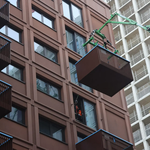I don't think that is true at all.
There are a lot of places where there is simply not enough room to build a ramp from 127mm to 1220mm. What do you do there? Stairs are applicable in some, sure, but most certainly not at existing ramps or at elevators. It seems to me that that ultimate answer at those locations is rebuilding the elevator as a whole, and that's certainly a heck of a lot more expensive than just building a ramp out of cheap materials such as concrete or dirt+asphalt.
Dan
Most platforms on the lines shared with VIA are accessed by stairs/elevators, not ramps, and those which are accessed by ramps tend to be the ones where there is abundant space. So the question is really how many of the existing elevators could stay where they are despite 610mm boarding. I think the answer is not that many, given that so many stations are being reconstructed anyway.
Take for example the number of future platforms on the Stouffville line which were reused from the pre-2015 stations:
Number of platforms in future (number of those which are the currently existing platforms)
East Harbour: 3 platforms, (0 existing)
Danforth: 3 platforms (0 or 1 existing, depending on design)
Kennedy: 2 platforms (0 existing*)
Agincourt: 2 platforms (0 existing*)
Milliken: 2 platforms (0 existing*)
Unionville: 2 platforms (0 existing**)
Centennial: 1 platform (1 existing)
Markham: 1 platform (1 existing)
Mount Joy: 2 platforms (0 existing**)
Stouffville: 1 platform (1 existing)
Lincolnville / Tree in the Parking Lot: 1 platform (0 existing)
* these platforms exist now, but didn't exist prior to GO expansion
** one platform existed prior to GO expansion, but the elevators did not
By my reckoning, only 3 or 4 of the 20 platforms which will be in place post-GO expansion are using the same vertical circulation which existed prior to GO Expansion.
If we had decided on 1220mm platforms five years ago, these stations could have been built at 1220mm from scratch, which is only marginally more expensive than building to 610mm. However, as I stated in my earlier post, the ship on 1220mm has already sailed, and we should instead be focusing on keeping the political pressure on the upgrade to 610mm.







